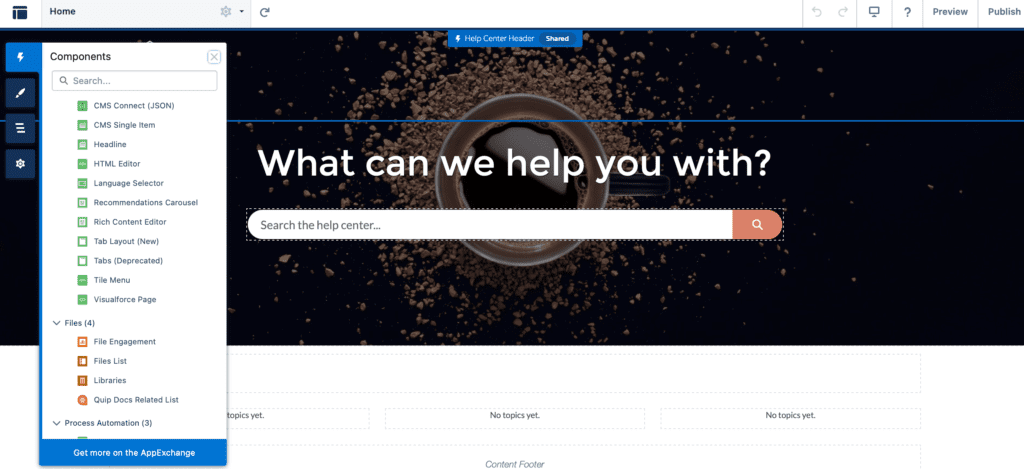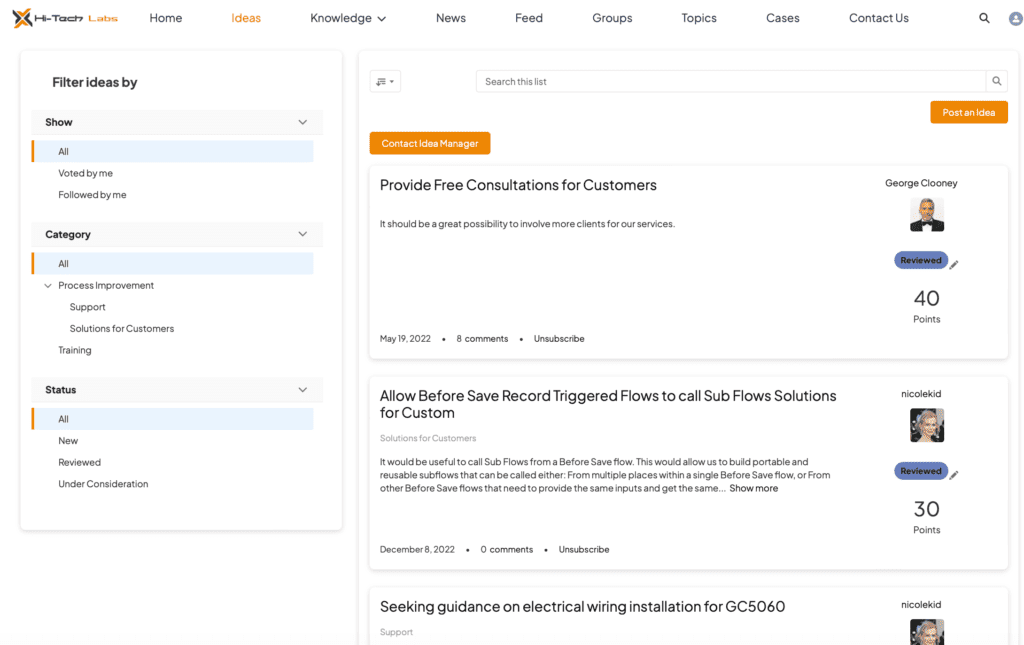So, you know how the digital world is always changing and evolving, right? Well, Salesforce is a no exception. It is constantly improving their services and products to keep up with the growing demands of modern businesses. One notable shift in this journey is the transformation of Salesforce’s Community Cloud into what is now known as Salesforce Experience Cloud. But what does this rebranding mean? Does the Salesforce Community Cloud still exist in its previous form? And how does the Experience Cloud differ? This is exactly what we’ll explore in this “Salesforce Experience Cloud vs Community Cloud” blog. Let’s get it started!
Salesforce Community Cloud evolution: from Community to Experience
For those familiar with Salesforce’s offerings, the transition from Community Cloud to Experience Cloud might raise some questions. Indeed, the Salesforce Community Cloud has not disappeared entirely but has rather undergone a metamorphosis. Renamed as Salesforce Experience Cloud, this platform continues to provide the tools and features necessary for creating dynamic Salesforce communities.
Salesforce’s rationale behind this renaming is clear: the term “Community” no longer covers the full breadth of possibilities offered by this cloud service. With Experience Cloud, Salesforce aims to emphasize the holistic nature of the digital experiences it enables, spanning interactions with customers, partners, and employees alike.
Salesforce Experience Cloud: empowering digital interactions
So, what is Salesforce Experience Cloud? Simply put, it is a DXP (digital experience) platform designed to empower businesses that use Salesforce in creating branded sites and online communities within the Salesforce platform. These communities sit on top of Salesforce and serve as hubs for interaction, communication, collaboration, and engagement across various stakeholders.
The Experience Cloud platform site basically serves as a window to your Salesforce CRM data, allowing users to interact with that data through a beautiful site, getting the digital experience they are expecting.
Whether your goal is to connect with customers, empower employees, or engage business partners, Experience Cloud provides the tools to tailor your digital presence accordingly. From building interactive websites to self-service and partner portals, the possibilities are vast. The platform serves for curating connected digital experiences that provide access to relevant resources and establish meaningful interactions.
Salesforce Community Cloud vs Experience Cloud: what changed?
So, let’s speak about Salesforce Experience Cloud vs Community Cloud changes. While the rebranding signifies a shift in focus and branding, the core functionalities largely remain the same. Both platforms enable the creation and management of communities, with Experience Cloud offering a more refined and integrated approach.
One significant change lies in the terminology and user interface. The transition to Experience Cloud introduces updated terminology, such as referring to user interfaces and documentation as “Site or Experience Cloud Site” instead of “Community.” Also, “Lightning Community” has become “Experience Builder site”, and “Lightning Community template/theme/page” is changed to “Experience Builder template/theme/page.”
The platform has also got a lot of enhancements and rich updates such as:
- New components that provide unique features available for B2B commerce. These include the New Lightning Web Component Header, Cart Scale, and the Guest Browsing component.
- Improved system security. Salesforce removed the following guest user object permissions: Edit, Delete, View All&Modify All, ensuring minimum impact to the org and maximum protection.
- Mobile Publisher enhancements. The customers can now build mobile apps with Mobile Publisher for iPhone and iPad, and also have the ability to lock the orientation to landscape or portrait.
Salesforce Experience Cloud: What Is It and How Can It Help You?

Salesforce Experience Cloud key benefits
Integration with Salesforce org
The Experience Cloud platform site goes beyond mere website creation. It represents a tightly integrated extension of your Salesforce CRM ecosystem, designed to facilitate interaction between your organization and its stakeholders. The real difference from other platforms lies in deep integration with your Salesforce org. Unlike standalone website builders, a Salesforce Experience Cloud uses the robust features of the Salesforce platform, including user management, permissions, data access, flows, and more. This means that the tools and functionalities that make Salesforce so powerful are readily available for use within your community environment. From managing user permissions to accessing and sharing Salesforce data, the Experience Cloud site streamlines business processes and enhances collaboration. Besides, sites can be seamlessly integrated with other Salesforce solutions like Sales Cloud, Marketing Cloud, and Service Cloud, enabling the flow of data and information between systems.
Let’s use an example: By using a Salesforce Experience Cloud partner portal, your partners can access and interact with important data such as leads, opportunities, deals, make reports, receive support, undergo onboarding, and much more. Now, consider a company website built on an external platform, providing general information about services, products, team, etc. This website would derive almost no benefit from being tied to your org, thus the high cost would be unjustified.
A no-code development approach
One significant benefit of Experience Cloud lies in its no-code development approach, which allows users to create Salesforce communities and sites without extensive coding knowledge. This is all possible with the Experience Builder, a no-code development tool integrated into Experience Cloud. Experience Builder provides ready-to-use drag-and-drop functionality to develop and customize powerful CRM-driven digital experiences fast, and with very low setup costs. You simply need to utilize drag-and-drop features or a combination of standard and custom components to build the digital experience tailored to your needs. This is a huge advantage of the platform as you can use the existing development without relying too much on web developers, while ensuring compliance with Salesforce security standards, and seamless integration with the CRM system.
However, it’s important to note that even though Salesforce Experience Cloud is great at making development easier, it may not always deliver pixel-perfect user experiences. Some may find this limitation to be a drawback, particularly if precision in design is crucial. And here a solution – custom design done by a Salesforce partner like Advanced Communities. AC has been providing Salesforce UI/UX design services for years creating intuitive digital experiences that users love. Feel free to reach out to get help.

Third party apps integration
Salesforce Experience Cloud digital experiences can be enhanced by custom apps and components known as Salesforce Accelerators that are readily available on AppExchange. These apps expand the out-of-the-box functionality of the site ensuring it gets features previously not available in the platform. For instance, you can use a powerful Salesforce events app to establish a robust event management system on your site. Or supercharge your Salesforce Knowledge by implementing AC Knowledge Management Enterprise, a powerful Knowledge base solution for Salesforce Community Cloud. All these apps with will help you improve community engagement and customer satisfaction providing functionality your users expect.
Conclusion
The transformation from Salesforce Community Cloud to Experience Cloud marks a significant step towards a more unified and versatile platform. Despite the name change, the core objective remains the same: to empower organizations in crafting meaningful digital experiences. Whether it’s connecting with customers, collaborating with employees, or involving partners, Salesforce continues to stick to this promise.
If you need help with setting up and configuring your Experience Cloud platform, Advanced Communities team is here for you. We’ve been building Salesforce communities and custom solutions for Experience Cloud for years, and that’s what we now the best. We can also help with Salesforce data migration and custom design for your site. Contact us for all your Salesforce needs, including understanding the nuances of Salesforce Experience Cloud vs Community Cloud.
Subscribe to our Newsletter
Receive regular updates on our latest blog posts, news, and exclusive content!
Q&A
Is Salesforce Community Cloud same as Experience Cloud?
Yes, Salesforce Community Cloud is now known as Salesforce Experience Cloud. The rebranding occurred to reflect the broader scope of capabilities offered by the platform, which extends beyond traditional community-building features to encompass a wide range of digital experience creation tools. So, while the name has changed, the core functionalities of the platform remain largely the same, with enhancements and updates under the new branding.
What is Salesforce Experience Cloud?
Experience Cloud is a platform provided by Salesforce that enables businesses to create branded sites for their customers and partners. Formerly known as Salesforce Community Cloud, it offers a range of tools and features to build interactive sites, self-service portals, and online communities. These digital experiences can be tailored to specific audiences and designed to facilitate communication, collaboration, and engagement. Use the power of Salesforce to streamline operations, enhance customer satisfaction, and drive growth!
Is Salesforce CMS part of Experience Cloud?
Yes, Salesforce CMS (Content Management System) is indeed part of Salesforce Experience Cloud.












